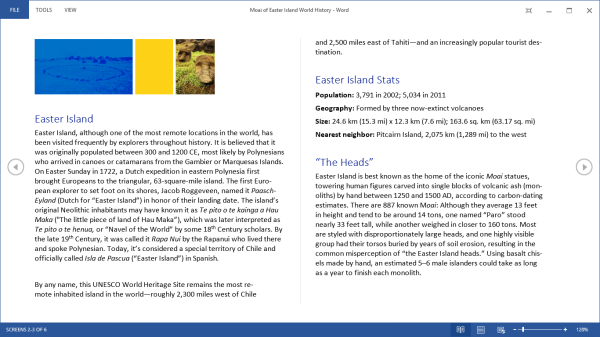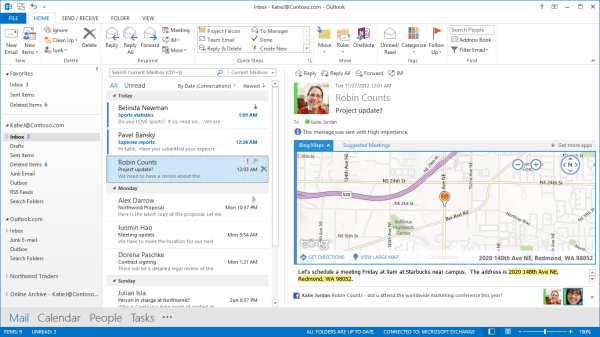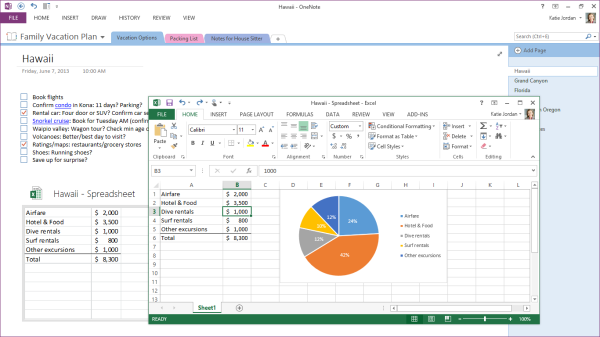Three Months with Microsoft's Office 365
by Vivek Gowri on January 31, 2013 11:59 PM EST- Posted in
- Microsoft
- Cloud Computing
- Office 2013
- SkyDrive
Word 2013 has a couple of nice features worth calling out. One is a viewing mode designed specifically for reading, which is pretty similar in theory to Reader mode in Safari, with text reflowing in columns to fit the display and all navigation and editing tools being hidden to present the document in a consumption-centric manner. The other is much better handling of PDFs - Word 2013 can now open PDFs and treat most content (text, tablets, formatting) exactly the same as standard Word docs. If you’ve ever had to deal with the nightmare of copying content from PDFs to Word, this is wonderful news. Unfortunately, now I’m done with college; it’s unfortunate that Microsoft didn’t decide to implement this in Word 2007 when it would have been legitimately useful to me. (Sidenote: perhaps this is a sign that I’m getting old, but I’ve had a number of moments in the first month of this year when I see new tech products and think to myself “Damn, I would have killed for that 5 years ago when I was an undergrad.”)
PowerPoint comes with significantly better audio and video media support, the ability to add pictures from online directly to the presentation instead of having to save and insert them, a new presenter view when you have a second screen (which is done automatically), more (and better) themes, some cool new transitions (in a category called “Exciting”), and better sharing and editing tools.
Excel’s improvements are primarily related to new charting options, but also a couple of new data tools. The new chart object styles are awesome, and the customizability of the data point styles and transparencies is much easier than it used to be. Other than new content and the visual refresh, the way you interact with the software hasn’t fundamentally changed much with the added features, which is why I’m kind of glossing over Excel and PowerPoint. They’re evolutionary improvements that don’t radically alter the user experience.
Outlook has been redesigned to look like a much more powerful version of the Windows 8 Mail application, with a colour scheme change from gold to blue. Inline replies are now the default, there are plenty of animations, and social networking integration is being touted as one of the more important new features. Clearly, this is not my father’s Outlook we’re talking about. It takes some of the better features from current mobile mail applications and integrates them into what was already the gold standard in desktop mail programs. There are new flyover boxes (called Peeks) to quickly show you schedule, calendar, or contact details without switching windows. The contact manager also does a better job of consolidating multiple contact details into a single card to reduce duplicates. Faster search, better filtering, and new views and in-line attachment and Bing map previews make the 2013 edition the sleekest and easiest version of Outlook yet. After using Outlook for a few days, going back to the Mail app is just a painful and torturous exercise.
With Office 2013, OneNote is making the jump from interesting and useful Office application to really being a vital component of the Office suite. With the rise of tablet computing and the touch-centric nature of Windows 8, this is understandable, particularly since most of the Intel-based tablets are coming with Wacom, N-Trig, or other active (pen-input) digitizers and even the Windows RT slates work well when paired with capacitive styli. That most Windows RT slates don’t come with capacitive pens out of the box is a failing of the device manufacturers, since the platform really lends itself to pen input.
OneNote 2013 features a lot of cross platform integration, with easily embedded objects and Office files (which automatically update when changed). So, if I was to put an Excel grocery list file into OneNote, any changes I made to it in Excel would be reflected in OneNote as well. Outlook meeting integration gives OneNote much more scope in the business realm than it previously had, particularly when combined with the improved search and linked audio features. Better inking, photo snipping, auto-save, and a full-page reading view just improve what OneNote was already great for.














113 Comments
View All Comments
Tams80 - Friday, February 8, 2013 - link
I agree. White space is badly used. There is a lack of contrast and worst it's painful on the eyes (even using 'dark' modes), which is certainly not helped by the CAPITALS. The menu uses too much screen estate. Then the whole look and feel just feels 'off' to me.Freakie - Friday, February 1, 2013 - link
I really dig the new student subscription to Office. It does suck that it only lasts a max of 8 years, but picking up new .edu email addresses aren't the most difficult thing in the world... Though were 365 really shines is if your university/business has an Enterprise subscription with Lync. Our university did just that and rolled out Lync to everyone last week and it is POWERFUL. It radically changes how us students can collaborate with each other and our professors and really integrates well with a bunch of devices making it really versatile. It's a huge upgrade for us xP And any university in my opinion.VivekGowri - Friday, February 1, 2013 - link
Yeah, our university gave everyone Professional Plus with Lync. I dunno how it's going to play out (or even if that many people will upgrade) but it could end up being really awesome in the future.Freakie - Friday, February 1, 2013 - link
So far it seems that most on our campus have positive feelings about it. We also switched our webmail over to Office 365 so that was even bigger than adding in Lync, and that's were most of the complaints are coming from. But our University, UC Merced, is less than 10 years old and with all the technology teething pains that have gone on since the school's start, it's not as hard to get people to switch or start using a new system because we're all used to it by now. Plus it's a pretty small campus, so IT's evangelist efforts to get people using Lync don't fall on deaf ears and they don't have nearly as much trouble reaching everyone as larger universities do.steven75 - Sunday, February 3, 2013 - link
How is it better than other universities that have been using gmail (via Google Apps) with that built in for years now?CeriseCogburn - Friday, February 1, 2013 - link
iCloud looks like iFool on some levels.beginner99 - Friday, February 1, 2013 - link
I paid less than that price for a bundle with 3 licenses of Office 2010 containing the exact same applications. Just double check and on the shop I use you can actually see it right next to each other, office 2010 with 3 licenses and office 2013 with 1 for exactly the same price. (and I paid less over a year ago for that bundle with 3 licenses than it costs now).So basically MS managed to increase the price by 300%....and people don't even mention it in reviews? Even worse:
" It’s great. If you’ve got 4 or 5 computers to install Office on, $99/year isn’t bad at all"
With Office 2010 I could get 6 licenses for about double that price. But then I can use them as long as I want not just 1 year. Yes, my bundle is missing Access but then most home users don't need that anyway and also most home users keep an office version for years, I would say 5-10 years is not uncommon.
Sorry no. They managed to increases price massively and reviewers applaud for it??? Well, will probably switch to libre-office once my 2010 is outdated.
A5 - Friday, February 1, 2013 - link
Um, your prices are way below what nearly all non-academic users paid. You sure you weren't buying the RZR1911 edition?beginner99 - Friday, February 1, 2013 - link
No idea what you mean b yRZR1911 but here a link:http://www.newegg.com/Product/Product.aspx?Item=N8...
That's $139 for 3 PCs.
Arbie - Friday, February 1, 2013 - link
Thanks for the link. And A5 owes you an apology.